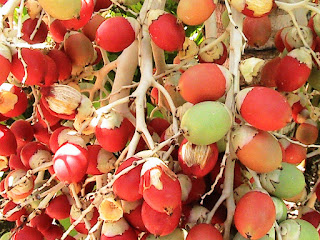Located on the waterfront, it's the sort of place where you could sit on deck chairs for hours on end and watch the slow pace of life go by in Admiralty Bay. Fishermen and children would walk past, by the water's edge. Yachties would tie up their inflatable boats on the pier and then come to the Frangi for a beer and to catch up on news of home from their netbooks. Almost everyone who visits Bequia ends up going at least once to this island meeting place. Even Harrison Ford has been seen propping up the bar, casually dressed in shorts and tshirt and talking to locals.
The Frangi has an al-fresco dining area, where, amongst other things, they serve a great traditional English fry-up and strong pots of coffee for breakfast. There is also very good seafood and on Thursday night, a barbeque and a steel band attracts yachties and locals alike.

The Frangi has a fascinating history.
In 1897, this strip of land along the waterfront was bought by James "Harry" Mitchell, a descendant of Scottish immigrants and African slaves, for his wife as a wedding gift. For this boat-building family, the land was used for constructing wooden schooners and fishing boats. Then, after a devastating hurricane in 1927, the two-storey stone and wood house, with its steep roof (as protection against strong winds) was built in 1931. It still stands to this day, with many of the original features and materials in place.
Over the next thirty years, the downstairs section was used as a chandlery and storage area, while the upstairs, with a view over the bay, was the living quarters.
In 1939, the Gloria Colita, largest of all the wooden schooners ever built on Bequia, was launched from the property. A year later, while transporting trade goods, it was found drifting and battered in the Bermuda Triangle, with all crew missing, including Reginald Mitchell (Harry's son).
Twenty-something years later, in 1967, the Frangipani was opened as a hotel, by James "Son" Mitchell (Reginald's son). He had returned to his birthplace from agricultural studies and work in Trinidad, Canada and Europe, at a time when tourism in the Caribbean was begining to take off.
In the following years, while running the hotel and bringing up a family, James became a political representative in the Grenadine islands. This was the start of his political career, which took him on to becoming a Premier in the 70s (before independence in 1979), setting up the NDP party and then serving as Prime Minister of St Vincent and the Grenadines, for four consecutive terms from 1984 to 2001.
James and his siblings were delivered by the island's only midwife in what is now room number 1 at the front of the original house. It happened to be the room I was staying in and I think it's the first time I've slept in a Prime Minister's birthplace. I felt quite honoured.
I loved staying in the 1930s house, with its original woodwork, simple furnishings and veranda overlooking the sea. This, for me, felt like the quintessential Caribbean.
For those wanting a bit more luxury and larger rooms, the Frangipani also has garden cottages, built from local stone and hardwoods, and located on a low rise in the grounds of the property.
Graded into Garden, Deluxe Hillside and Air Con Deluxe, all ensuite rooms are super comfortable and cool, with stone and wood interiors.
From their terraces, the view of Admiralty Bay is superb.
Rooms at the Frangipani vary from US$50 for single use of a Standard room in the original house in low season, to US$250 for the Air Con Deluxe in high season. A 10% service charge is not included.
The Frangi, with its unbeatable seafront location, charm, relaxed atmosphere, interesting local history and friendly family-run atmosphere is a recommendation for anyone coming to Bequia.
For further information, please visit www.frangipanibequia.com






















































